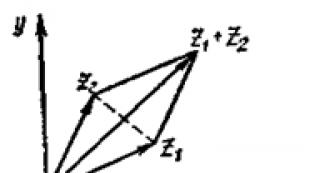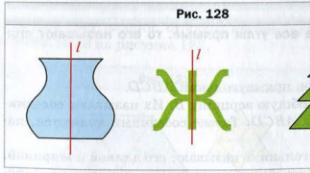Math lesson. Topic: "Axis of symmetry". How many axes of symmetry does a triangle have? — Useful information for everyone All axes of symmetry of a triangle
If a quadrilateral has all right angles, then it is called a rectangle.
Figure 125 shows a rectangle ABCD.
The sides AB and BC have a common vertex B. They are called neighboring sides of rectangle ABCD. Also adjacent are, for example, sides BC and CD.
The adjacent sides of a rectangle are called length And width.
Sides AB and CD do not have common vertices. They are called opposite sides of rectangle ABCD. Also opposite are the sides BC and AD.
Opposite sides of a rectangle are equal.
In the figure 125 AB = CD, BC = AD. If the length of the rectangle is a and the width is b, then its perimeter is calculated using the formula already familiar to you:
P = 2a + 2b
A rectangle with all sides equal is called square(Fig. 126).
Let's draw a straight line l passing through the midpoints of two opposite sides of the rectangle (Fig. 127). If a sheet of paper is folded along a straight line l, then the two parts of the rectangle lying on opposite sides of the straight line l will coincide.
The figures shown in Figure 128 have a similar property. Such figures are called symmetrical about a straight line . The line l is called the axis of symmetry of the figure .
So, a rectangle is a figure that has an axis of symmetry. Also, the axis of symmetry has an isosceles triangle (Fig. 129).
A figure can have more than one axis of symmetry. For example, a rectangle other than a square has two axes of symmetry ( fig. 130), and a square has four axes of symmetry ( fig. 131). An equilateral triangle has three axes of symmetry (Fig. 132).
When studying the world around us, we often encounter symmetry. Examples of symmetry in nature are shown in Figure 133.
Objects that have an axis of symmetry are easy to perceive and pleasing to the eye. No wonder in ancient Greece the word "symmetry" served as a synonym for the words "harmony", "beauty".
The idea of symmetry is widely used in fine arts and architecture (Fig. 134).
Goals:
- educational:
- give an idea of \u200b\u200bsymmetry;
- introduce the main types of symmetry in the plane and in space;
- develop strong skills in constructing symmetrical figures;
- expand ideas about famous figures by introducing them to the properties associated with symmetry;
- show the possibilities of using symmetry in solving various problems;
- consolidate the acquired knowledge;
- general education:
- learn to set yourself up for work;
- teach to control oneself and a neighbor on the desk;
- to teach how to evaluate yourself and a neighbor on your desk;
- developing:
- activate independent activity;
- develop cognitive activity;
- learn to summarize and systematize the information received;
- educational:
- educate students "a sense of shoulder";
- cultivate communication;
- inculcate a culture of communication.
DURING THE CLASSES
In front of each are scissors and a sheet of paper.
Exercise 1(3 min).

- Take a sheet of paper, fold it in half and cut out some figure. Now unfold the sheet and look at the fold line.
Question: What is the function of this line?
Suggested answer: This line divides the figure in half.
Question: How are all the points of the figure located on the two resulting halves?
Suggested answer: All points of the halves are at an equal distance from the fold line and at the same level.
- So, the fold line divides the figure in half so that 1 half is a copy of 2 halves, i.e. this line is not simple, it has a remarkable property (all points relative to it are at the same distance), this line is the axis of symmetry.
Task 2 (2 minutes).
- Cut out a snowflake, find the axis of symmetry, characterize it.
Task 3 (5 minutes).
- Draw a circle in your notebook.
Question: Determine how the axis of symmetry passes?
Suggested answer: Differently.
Question: So how many axes of symmetry does a circle have?
Suggested answer: A lot of.
- That's right, the circle has many axes of symmetry. The same wonderful figure is the ball (spatial figure)

Question: What other figures have more than one axis of symmetry?
Suggested answer: Square, rectangle, isosceles and equilateral triangles.

– Consider three-dimensional figures: a cube, a pyramid, a cone, a cylinder, etc. These figures also have an axis of symmetry. Determine how many axes of symmetry a square, rectangle, equilateral triangle and the proposed three-dimensional figures have?
I distribute the halves of plasticine figures to the students.
Task 4 (3 min).
- Using the information received, finish the missing part of the figure.
Note: the figurine can be both flat and three-dimensional. It is important that students determine how the axis of symmetry goes and fill in the missing element. The correctness of the performance is determined by the neighbor on the desk, evaluates how well the work has been done.
A line is laid out from a lace of the same color on the desktop (closed, open, with self-crossing, without self-crossing).
Task 5 (group work 5 min).

- Visually determine the axis of symmetry and, relative to it, complete the second part from a lace of a different color.
The correctness of the work performed is determined by the students themselves.
The students are presented with elements of drawings

Task 6 (2 minutes).
Find the symmetrical parts of these drawings.
To consolidate the material covered, I propose the following tasks, provided for 15 minutes:

Name all equal elements of the triangle KOR and KOM. What are the types of these triangles?
2. Draw in a notebook several isosceles triangles with a common base equal to 6 cm.
3. Draw a segment AB. Construct a line perpendicular to segment AB and passing through its midpoint. Mark points C and D on it so that the quadrilateral ACBD is symmetrical with respect to the line AB.
- Our initial ideas about the form belong to a very distant era of the ancient Stone Age - the Paleolithic. For hundreds of thousands of years of this period, people lived in caves, in conditions that differed little from the life of animals. People made tools for hunting and fishing, developed a language to communicate with each other, and in the late Paleolithic era, they decorated their existence by creating works of art, figurines and drawings, which reveal a wonderful sense of form.
When there was a transition from simple gathering of food to its active production, from hunting and fishing to agriculture, humanity enters a new stone age, the Neolithic.
Neolithic man had a keen sense of geometric form. The firing and coloring of clay vessels, the manufacture of reed mats, baskets, fabrics, and later metal processing developed ideas about planar and spatial figures. Neolithic ornaments were pleasing to the eye, revealing equality and symmetry.
Where is symmetry found in nature?
Suggested answer: wings of butterflies, beetles, tree leaves…

“Symmetry can also be seen in architecture. When constructing buildings, builders clearly adhere to symmetry.

That's why the buildings are so beautiful. Also an example of symmetry is a person, animals.

Homework:
1. Come up with your own ornament, depict it on an A4 sheet (you can draw it in the form of a carpet).
2. Draw butterflies, mark where there are elements of symmetry.
There are two types of symmetry: central and axial. With central symmetry, any straight line drawn through the center of the figure divides it into two absolutely identical parts that are completely symmetrical. In simple terms, they are mirror images of each other. An infinite number of such lines can be drawn near the circle, in any case they will divide it into two symmetrical parts.
Axis of symmetry
Most geometric shapes do not have such characteristics. In them, only the axis of symmetry can be drawn, and then not for everyone. The axis is also a straight line that divides the figure into symmetrical parts. But for the axis of symmetry, there is only a certain location, and if it is slightly changed, then the symmetry will be broken.
It is logical that each square has an axis of symmetry, because all its sides are equal and each angle is equal to ninety degrees. Triangles are different. Triangles with all sides different cannot have an axis or a center of symmetry. But in isosceles triangles, you can draw an axis of symmetry. Recall that a triangle with two equal sides and, accordingly, two equal angles adjacent to the third side, the base, is considered to be isosceles. For an isosceles triangle, the axis will be a straight line passing from the top of the triangle to the base. In this case, this line will be both a median and a bisector, since it will bisect the angle and reach exactly the middle of the third side. If a triangle is folded along this straight line, then the resulting figures will completely copy each other. However, in an isosceles triangle, there can be only one axis of symmetry. If another straight line is drawn through its center, then it will not divide it into two symmetrical parts.
special triangle
An equilateral triangle is unique. This is a special kind of triangle, which is also isosceles. True, each side of it can be considered a base, since all its sides are equal, and each angle is sixty degrees. Therefore, an equilateral triangle has three axes of symmetry. These lines converge at one point in the center of the triangle. But even such a feature does not turn an equilateral triangle into a figure with central symmetry. Even an equilateral triangle does not have a center of symmetry, since through the indicated point only three straight lines divide the figure into equal parts. If you draw a straight line in the other direction, then the triangle will no longer have symmetry. This means that these figures have only axial symmetry.
Axial symmetry is symmetry about a line.
Let some straight line g.
To construct a point symmetric to some point A about a line g, necessary:
 1) Draw from point A to a straight line g perpendicular AO.
1) Draw from point A to a straight line g perpendicular AO.
 2) On the continuation of the perpendicular on the other side of the line g set aside segment OA1 equal to segment AO: OA1=AO.
2) On the continuation of the perpendicular on the other side of the line g set aside segment OA1 equal to segment AO: OA1=AO.
The resulting point A1 is symmetrical to point A with respect to the line g.
Straight g called the axis of symmetry.
Thus, points A and A1 are symmetric about a line g if this line passes through the midpoint of segment AA1 and is perpendicular to it.
If the point A lies on the line g, then the point symmetric to it is the point A itself.
Transformation of a figure F into a figure F1, in which each of its points A passes into a point A1, symmetrical with respect to a given line g, is called the symmetry transformation with respect to the line g.
Figures F and F1 are called figures that are symmetrical with respect to a straight line. g.
 To construct a triangle symmetrical to a given one with respect to a line g, it is enough to construct points symmetrical to the vertices of the triangle, and connect them with segments.
To construct a triangle symmetrical to a given one with respect to a line g, it is enough to construct points symmetrical to the vertices of the triangle, and connect them with segments. For example, triangles ABC and A1B1C1 are symmetrical about a line g.
If the symmetry transformation about a line g takes a figure into itself, then such a figure is called symmetrical with respect to a straight line g, and the straight line g called its axis of symmetry.
A symmetrical figure is divided by its axis of symmetry into two equal halves. If a symmetrical figure is drawn on paper, cut out and bent along the axis of symmetry, then these halves will match.
Examples of figures symmetrical about a straight line.
1) Rectangle.
The rectangle has 2 axes of symmetry: straight lines passing through the point of intersection of the diagonals parallel to the sides.

The rhombus has two axes of symmetry:
the lines on which its diagonals lie.
3) A square, like a rhombus and a rectangle, has four axes of symmetry: straight lines containing its diagonals, and straight lines passing through the point of intersection of the diagonals parallel to the sides.
4) Circle.
The circle has an infinite number of axes of symmetry:
any straight line containing the diameter is the axis of symmetry of the circle.
A straight line also has an infinite number of axes of symmetry: any straight line perpendicular to it is an axis of symmetry for a given straight line.
6) Isosceles trapezoid.

An isosceles trapezoid is a figure symmetrical about a straight line perpendicular to the bases and passing through their midpoints.
7) Isosceles triangle.
An isosceles triangle has one axis of symmetry:
a straight line passing through the height (median, bisector) drawn to the base.
8) An equilateral triangle.
An equilateral triangle has three axes of symmetry:

An angle is a figure that is symmetrical with respect to the line containing its bisector.
Axial symmetry is movement.
Symmetry
Since ancient times, people have sought to streamline the world around them. Therefore, something is considered beautiful, and something not so. From an aesthetic point of view, golden and silver sections are considered attractive, as well as, of course, symmetry. This term is of Greek origin and literally means "proportion". Of course, we are talking not only about coincidence on this basis, but also on some others. In a general sense, symmetry is such a property of an object when, as a result of certain formations, the result is equal to the original data. It is found in both animate and inanimate nature, as well as in objects made by man.
First of all, the term "symmetry" is used in geometry, but finds application in many scientific fields, and its meaning remains generally unchanged. This phenomenon is quite common and is considered interesting, since several of its types, as well as elements, differ. The use of symmetry is also interesting, because it is found not only in nature, but also in ornaments on fabric, building borders and many other man-made objects. It is worth considering this phenomenon in more detail, because it is extremely exciting.

Use of the term in other scientific fields
In the future, symmetry will be considered from the point of view of geometry, but it is worth mentioning that this word is used not only here. Biology, virology, chemistry, physics, crystallography - all this is an incomplete list of areas in which this phenomenon is studied from different angles and under different conditions. The classification, for example, depends on which science this term refers to. Thus, the division into types varies greatly, although some basic ones, perhaps, remain unchanged everywhere.
Classification
There are several basic types of symmetry, of which three are most common:

In addition, the following types are also distinguished in geometry, they are much less common, but no less curious:
- sliding;
- rotational;
- point;
- progressive;
- screw;
- fractal;
- etc.
In biology, all species are called somewhat differently, although in fact they can be the same. The division into certain groups occurs on the basis of the presence or absence, as well as the number of certain elements, such as centers, planes and axes of symmetry. They should be considered separately and in more detail.
Basic elements

Some features are distinguished in the phenomenon, one of which is necessarily present. The so-called basic elements include planes, centers and axes of symmetry. It is in accordance with their presence, absence and quantity that the type is determined.
The center of symmetry is called the point inside the figure or crystal, at which the lines converge, connecting in pairs all sides parallel to each other. Of course, it doesn't always exist. If there are sides to which there is no parallel pair, then such a point cannot be found, since there is none. According to the definition, it is obvious that the center of symmetry is that through which the figure can be reflected on itself. An example is, for example, a circle and a point in its middle. This element is usually referred to as C.
The plane of symmetry, of course, is imaginary, but it is she who divides the figure into two parts equal to each other. It can pass through one or more sides, be parallel to it, or it can divide them. For the same figure, several planes can exist at once. These elements are usually referred to as P.
But perhaps the most common is what is called "axes of symmetry." This frequent phenomenon can be seen both in geometry and in nature. And it deserves separate consideration.
axes
Often the element with respect to which the figure can be called symmetrical, 
is a straight line or a segment. In any case, we are not talking about a point or a plane. Then the axes of symmetry of the figures are considered. There can be a lot of them, and they can be located in any way: divide sides or be parallel to them, as well as cross corners or not. Axes of symmetry are usually denoted as L.
Examples are isosceles and equilateral triangles. In the first case, there will be a vertical axis of symmetry, on both sides of which there are equal faces, and in the second, the lines will intersect each corner and coincide with all bisectors, medians, and heights. Ordinary triangles do not have it.
By the way, the totality of all the above elements in crystallography and stereometry is called the degree of symmetry. This indicator depends on the number of axes, planes and centers.
Examples in Geometry

It is conditionally possible to divide the entire set of objects of study of mathematicians into figures that have an axis of symmetry, and those that do not. All regular polygons, circles, ovals, as well as some special cases automatically fall into the first category, while the rest fall into the second group.
As in the case when it was said about the axis of symmetry of the triangle, this element for the quadrilateral does not always exist. For a square, rectangle, rhombus or parallelogram, it is, but for an irregular figure, accordingly, it is not. For a circle, the axis of symmetry is the set of straight lines that pass through its center.
In addition, it is interesting to consider volumetric figures from this point of view. At least one axis of symmetry, in addition to all regular polygons and the ball, will have some cones, as well as pyramids, parallelograms and some others. Each case must be considered separately.
Examples in nature
Mirror symmetry in life is called bilateral, it is most common
often. Any person and very many animals are an example of this. The axial one is called radial and is much less common, as a rule, in the plant world. And yet they are. For example, it is worth considering how many axes of symmetry a star has, and does it have them at all? Of course, we are talking about marine life, and not about the subject of study of astronomers. And the correct answer would be this: it depends on the number of rays of the star, for example, five, if it is five-pointed.
In addition, many flowers have radial symmetry: daisies, cornflowers, sunflowers, etc. There are a huge number of examples, they are literally everywhere around.
Arrhythmia
This term, first of all, reminds most of medicine and cardiology, but it initially has a slightly different meaning. In this case, the synonym will be "asymmetry", that is, the absence or violation of regularity in one form or another. It can be found as an accident, and sometimes it can be a beautiful device, for example, in clothing or architecture. After all, there are a lot of symmetrical buildings, but the famous Leaning Tower of Pisa is slightly tilted, and although it is not the only one, this is the most famous example. It is known that this happened by accident, but this has its own charm.
In addition, it is obvious that the faces and bodies of people and animals are also not completely symmetrical. There have even been studies, according to the results of which the "correct" faces were regarded as inanimate or simply unattractive. Still, the perception of symmetry and this phenomenon in itself are amazing and have not yet been fully studied, and therefore extremely interesting.
geometric symmetry
In relation to a geometric figure, symmetry means that if this figure is transformed - for example, rotated - some of its properties will remain the same.
The possibility of such transformations differs from figure to figure. For example, a circle can be rotated as much as you like around a point located in its center, it will remain a circle, nothing will change for it.
The concept of symmetry can be explained without resorting to rotation. It is enough to draw a straight line through the center of the circle and construct a segment perpendicular to it anywhere in the figure, connecting two points on the circle. The point of intersection with the line will divide the given segment into two parts, which will be equal to each other.
In other words, the straight line divided the figure into two equal parts. The points of the parts of the figure located on straight lines perpendicular to the given one are at an equal distance from it. This straight line will be called the axis of symmetry. Symmetry of this kind - relative to a straight line - is called axial symmetry.
Number of axes of symmetry
Different figures have different numbers of axes of symmetry. For example, a circle and a ball have many such axes. For an equilateral triangle, the axis of symmetry will be a perpendicular dropped to each of the sides, therefore, it has three axes. A square and a rectangle have four axes of symmetry. Two of them are perpendicular to the sides of the quadrangles, and the other two are diagonals. But an isosceles triangle has only one axis of symmetry, located between its equal sides.
Axial symmetry is also found in nature. It can be seen in two versions.
The first type is radial symmetry, which implies the presence of several axes. It is typical, for example, for starfish. More highly developed organisms are characterized by bilateral, or bilateral symmetry, with a single axis dividing the body into two parts.
The human body also has bilateral symmetry, but it cannot be called ideal. The legs, arms, eyes, lungs are symmetrical, but not the heart, liver or spleen. Deviations from bilateral symmetry are noticeable even outwardly. For example, it is extremely rare for a person to have identical moles on both cheeks.
Human life is filled with symmetry. It is convenient, beautiful, no need to invent new standards. But what is she really and is she as beautiful in nature as is commonly believed?
Symmetry
Since ancient times, people have sought to streamline the world around them. Therefore, something is considered beautiful, and something not so. From an aesthetic point of view, golden and silver sections are considered attractive, as well as, of course, symmetry. This term is of Greek origin and literally means "proportion". Of course, we are talking not only about coincidence on this basis, but also on some others. In a general sense, symmetry is such a property of an object when, as a result of certain formations, the result is equal to the original data. It is found in both animate and inanimate nature, as well as in objects made by man.
First of all, the term "symmetry" is used in geometry, but finds application in many scientific fields, and its meaning remains generally unchanged. This phenomenon is quite common and is considered interesting, since several of its types, as well as elements, differ. The use of symmetry is also interesting, because it is found not only in nature, but also in ornaments on fabric, building borders and many other man-made objects. It is worth considering this phenomenon in more detail, because it is extremely exciting.
Use of the term in other scientific fields
In the future, symmetry will be considered from the point of view of geometry, but it is worth mentioning that this word is used not only here. Biology, virology, chemistry, physics, crystallography - all this is an incomplete list of areas in which this phenomenon is studied from different angles and under different conditions. The classification, for example, depends on which science this term refers to. Thus, the division into types varies greatly, although some basic ones, perhaps, remain unchanged everywhere.
Classification
There are several basic types of symmetry, of which three are most common:

In addition, the following types are also distinguished in geometry, they are much less common, but no less curious:
- sliding;
- rotational;
- point;
- progressive;
- screw;
- fractal;
- etc.
In biology, all species are called somewhat differently, although in fact they can be the same. The division into certain groups occurs on the basis of the presence or absence, as well as the number of certain elements, such as centers, planes and axes of symmetry. They should be considered separately and in more detail.
Basic elements

Some features are distinguished in the phenomenon, one of which is necessarily present. The so-called basic elements include planes, centers and axes of symmetry. It is in accordance with their presence, absence and quantity that the type is determined.
The center of symmetry is called the point inside the figure or crystal, at which the lines converge, connecting in pairs all sides parallel to each other. Of course, it doesn't always exist. If there are sides to which there is no parallel pair, then such a point cannot be found, since there is none. According to the definition, it is obvious that the center of symmetry is that through which the figure can be reflected to itself. An example is, for example, a circle and a point in its middle. This element is usually referred to as C.
The plane of symmetry, of course, is imaginary, but it is she who divides the figure into two parts equal to each other. It can pass through one or more sides, be parallel to it, or it can divide them. For the same figure, several planes can exist at once. These elements are usually referred to as P.
But perhaps the most common is what is called "axes of symmetry." This frequent phenomenon can be seen both in geometry and in nature. And it deserves separate consideration.
axes
Often the element with respect to which the figure can be called symmetrical,

is a straight line or a segment. In any case, we are not talking about a point or a plane. Then the figures are considered. There can be a lot of them, and they can be located in any way: divide sides or be parallel to them, as well as cross corners or not. Axes of symmetry are usually denoted as L.
Examples are isosceles and In the first case there will be a vertical axis of symmetry, on both sides of which there are equal faces, and in the second the lines will intersect each angle and coincide with all bisectors, medians and heights. Ordinary triangles do not have it.
By the way, the totality of all the above elements in crystallography and stereometry is called the degree of symmetry. This indicator depends on the number of axes, planes and centers.
Examples in Geometry

It is conditionally possible to divide the entire set of objects of study of mathematicians into figures that have an axis of symmetry, and those that do not. All circles, ovals, as well as some special cases automatically fall into the first category, while the rest fall into the second group.
As in the case when it was said about the axis of symmetry of the triangle, this element for the quadrilateral does not always exist. For a square, rectangle, rhombus or parallelogram, it is, but for an irregular figure, accordingly, it is not. For a circle, the axis of symmetry is the set of straight lines that pass through its center.
In addition, it is interesting to consider volumetric figures from this point of view. At least one axis of symmetry, in addition to all regular polygons and the ball, will have some cones, as well as pyramids, parallelograms and some others. Each case must be considered separately.
Examples in nature
In life it is called bilateral, it occurs most
often. Any person and very many animals are an example of this. The axial one is called radial and is much less common, as a rule, in the plant world. And yet they are. For example, it is worth considering how many axes of symmetry a star has, and does it have them at all? Of course, we are talking about marine life, and not about the subject of study of astronomers. And the correct answer would be this: it depends on the number of rays of the star, for example, five, if it is five-pointed.
In addition, many flowers have radial symmetry: daisies, cornflowers, sunflowers, etc. There are a huge number of examples, they are literally everywhere around.

Arrhythmia
This term, first of all, reminds most of medicine and cardiology, but it initially has a slightly different meaning. In this case, the synonym will be "asymmetry", that is, the absence or violation of regularity in one form or another. It can be found as an accident, and sometimes it can be a beautiful device, for example, in clothing or architecture. After all, there are a lot of symmetrical buildings, but the famous one is slightly inclined, and although it is not the only one, this is the most famous example. It is known that this happened by accident, but this has its own charm.
In addition, it is obvious that the faces and bodies of people and animals are also not completely symmetrical. There have even been studies, according to the results of which the "correct" faces were regarded as inanimate or simply unattractive. Still, the perception of symmetry and this phenomenon in itself are amazing and have not yet been fully studied, and therefore extremely interesting.













